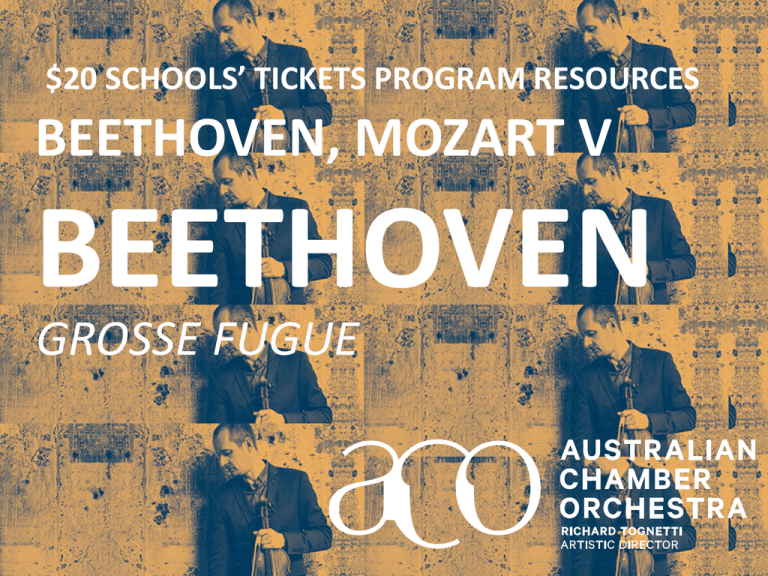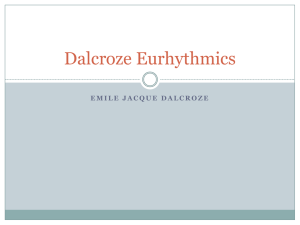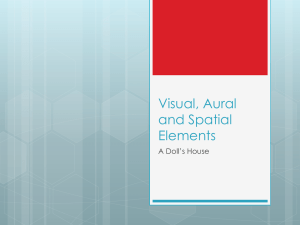BEETHOVEN, MOZART V BEETHOVEN
advertisement

$20 SCHOOLS’ TICKETS PROGRAM RESOURCES BEETHOVEN, MOZART V BEETHOVEN GROSSE FUGUE AUSTRALIAN CHAMBER ORCHESTRA One of the world’s most lauded chamber ensembles, the Australian Chamber Orchestra is renowned for its inspired programming and unrivalled virtuosity, energy and individuality. Its unique programming extends across six centuries, spanning popular masterworks, adventurous cross-artform projects and pieces specially commissioned for the ensemble. SEE THE ACO IN ACTION Outstanding Australian violinist Richard Tognetti has been at the helm of the ACO since 1989. LUDWIG VAN BEETHOVEN • SOME IMPORTANT FACTS: – One of the most influential composers of all time – Born in 1770 and died in 1827 – A transitionary figure – he was key in moving music from the Classical period – with strict form and function – to the Romantic period – which “broke rules” and emphasised emotional connections to music – Featured on a golden record, sent into space on the Voyager probe for aliens to find – Went profoundly deaf later in life – Most people consider his compositions later in life to be his best … which were also those he would never hear STRING QUARTET IN B FLAT MAJOR, OP.130 Composed 1825 Movements: 1.Adagio ma non troppo – Allegro 2. Presto 3. Andante con moto ma non troppo (poco scherzoso) 4. Alla danza tedesca: Allegro assai 5. Cavatina: Adagio molto espressivo 6. Grosse Fuge: •Overtura: Allegro(fuga) •Meno mosso e moderato •Allegro molto e con brio AURAL/ MUSICOLOGY • Each sequence of Lessons provided by the ACO will focus on developing key skills: PERFORMANCE, COMPOSITION and AURAL/MUSICOLOGY. • This sequence of lessons will focus on AURAL AND PERFORMANCE by examining STYLE • DISCLAIMER: This resource discusses using the concepts of Music. These are known as elements in Queensland and are different in other states, but are still central to the written response. STYLE • STYLE refers to the musical characteristics present in a given genre of music. • Many people use style and genre interchangeably. • It is the heavy backbeat in rock music – it is the clave rhythm in Latin music – terraced dynamics in baroque music. TERRACED DYNAMICS Expressive style typical of some early music in which volume levels shift abruptly from soft to loud and back without gradual crescendos and decrescendos • KNOWING elements of style for basic genres you encounter will help you in your aural and performance. • Let's go through these one at a time and find out how. CLAVE RHYTHM A rhythmic pattern used as a tool for temporal organization in Afro-Cuban music. Present in Abakuá music, rumba, conga, son, mambo, salsa, songo, timba and Afro-Cuban jazz. The five-stroke clave pattern represents the structural core of many Afro-Cuban rhythms. STYLE AND AURAL SKILLS • First, some revision. • In the last sequence of lessons (Cinemusica and Dvorak) we developed a scaffold to answer written aural questions. I'd highly recommend looking at it – it can be found on the ACO website. Here is a very quick recap . GREAT! • (Note - This resource discusses using the concepts of Music. These are known as elements in Queensland and are different in other states, but are still central to the written response.) Step one – get a scrap bit of paper, and write down what you hear. Step two – use these observations to write more complete answers on your answer sheets. Remember to: 1 – Use the language of the question 2 – Use the concepts of music 3 – Be as specific as possible PRACTICE QUESTION • Here's a practise question. • Listen to the first 60 seconds of Beethoven's Grosse Fugue • And answer the following question: • Describe how the concepts of music are used in the excerpt. • You can do this individually, or as a class. PRACTICE QUESTION • Many of you might be asking: So … how does knowing elements of style help me here? • Many students get stuck on step one. They don't know what to listen for, they don't know how or what to write down. This is where knowing style can help. • SO – if you know the style of Fugue, you now have things to look for, things to write about and fancy words to use. • • Try listening again, but this time, you know what you're listening for. The Fugue – Know your style! • Often contrapuntal (two or more independent melodic lines which intertwine) • Has two or more voices • Built around a theme that recurs in different voices • Often has a subject (the main theme) and a counter-subject (a development of the main theme.) PRACTICE QUESTION • Let's try a more popular Genre. • See if you can list elements of style for ROCK MUSIC ROCK MUSIC – elements of style PACTICE QUESTION - Instrumentation – Electric guitar, bass, drums, vocals • How many did you get? - Structurally – Strophic or verse/chorus - Heavy back beat - 4/4 time signature • So if you know the STYLE of the piece you're writing about, you have lots to say. • You could almost write a response without even listening to the music! • (Don't try this at home.) STYLE AND PERFORMANCE • Believe it or not, your examiners know their style, and it's one of the things they're listening for in your performances. • If you know the STYLE of the piece you are performing, you can demonstrate a deeper understanding of your piece by bringing out the stylistic characteristics. • Watch the video of BEETHOVEN again: • And, now knowing the style, see if you can see them. Look for: – – – – Counterpoint (more than one melody at a given time) The subject (the main theme that is repeated in many different voices) The counter-subject (a development of the main theme) Different voices that carry the subject and/or countersubject • Performance and Aural becomes a lot clearer with a deeper understanding of STYLE. ACTIVITY Each student picks a different style and make a poster for the room. Your goals are: • To teach your classmates, clearly and articulately, the elements of style for that genre. – Keep it CLEAR – Keep it SIMPLE – Keep it MEMORABLE • Every once in a while it might be a good idea to see how much you can remember about each style of music. GOOD LUCK! AT THE CONCERT • When you go to the concert, use the knowledge and skills we have explored and consider the following questions: • What elements of style can you hear in the ACO's performance? • How do they demonstrate their understanding of style? • How does their understanding of style change the performance? TEACHER’S NOTES Teacher's Notes for reference to the Draft Australian Curriculum: The Arts and NSW Stage 6 Music 1 & Music 2 Syllabus. General LIT – Reading the score, writing about the Concepts of Music Capabilities (CoM). NUM – Identifying and discussing meter and rhythm. ICT – Utilising internet resources. CCT – Critically discussing the set work/s. PSC – Sharing personal responses to set work/s. EU – Working collaboratively with peers in group discussions. ICU – Discussing cultural issues surrounding the set work/s. Cross-Curriculum Links & English, Humanities and Social Sciences, Mathematics, History, Priorities Language Viewpoints 2 – Extend discussions into the links between the repetitive nature of these works and that of cultural music of Asian regions (eg; Balinese, Chinese). TEACHER’S NOTES NSW Stage 6 Syllabus Links – MUSIC 1 Music of the 20th & 21st Topic Links Centuries Music for Small Ensembles Music and the Related Arts (Hermann & Stravinsky) MUSIC 1 P – 4,5,6,7,8,10,11 Outcome Links H – 4,5,6,7,8,10,11 MUSIC 2 Music 1900 – 1945 Topic Links Music 1945-25 Years Ago Music of the Last 25 Years (Although the Tüür work is not Australian) MUSIC 2 P – 4,5,6,7,8,10,11 Outcome Links H – 4,5,6,7,8,10,11 OPPORTUNITIES FOR YOUNG MUSICIANS WITH THE ACO Find out about more great opportunities with the ACO



